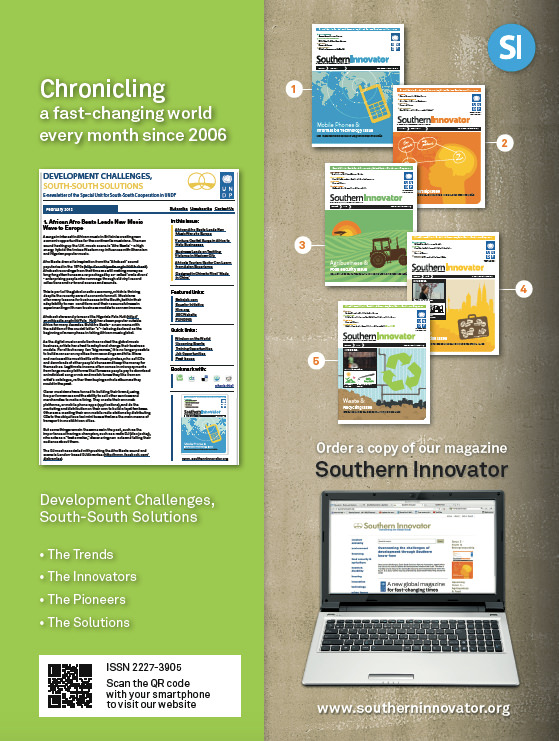South-South Cooperation for Cities in Asia
 Monday, June 15, 2015 at 5:32AM
Monday, June 15, 2015 at 5:32AM
By David South
southasiadisasters.net July 2014
The coming wave of technological innovations aimed at global South cities will dominate civic debates whether people wish it to or not. Already, futuristic, 21st-century cities are being built around Asia from scratch. I had the privilege of visiting a couple of them in 2012 while researching the fourth issue of our magazine, Southern Innovator (http://www.scribd.com/SouthernInnovator). Each city had a different focus for its construction - one was seeking to be an "eco-city" and the other one called itself a "smart city," focused on becoming a regional business and technology hub. Both aimed to use the latest information technologies to make the way Asian cities operate on a day-to-day basis smarter - and greener.
Large information technology companies - including India's Infosys (infosys.com) - have their sights set on selling all sorts of technological solutions to common problems of urban living. This aspiring revolution is built on two foundations: One is the Internet of Things - in which everyday objects are connected to the Internet via microchips. The other is Big Data, the vast quantities of data being generated by all the mobile phones and other electronic devices people use these days.
Much of this new technology will be manufactured in Asia, and not just that - it will also be developed and designed in Asia, often to meet the challenges of urban Asia.
By their nature, cities are fluid places. People come and go for work and pleasure, and successful cities are magnets for people of all backgrounds seeking new opportunities. This fluidity puts stress on cities and leads to the constant complaints familiar to any urban dweller - inadequate transport, traffic jams, air pollution, poor housing, and a high cost of living.
If handled well and with imagination, new information technologies can ensure Asian cities do more than pay lip service to aspirations to improve human development. They can make cities resilient places - able to bounce back from disasters, whether man-made or natural.
During the late 1990s, I saw first-hand the pressures placed on one Asian city, Mongolia's capital, Ulaanbaatar. The country endured the worst peacetime economic collapse since World War II while confronting the wrenching social and economic stresses of switching from a command economy during Communism to a free-market democracy. The city's population grew quickly as rural economies collapsed and poverty shot upwards. I can only imagine now how the response could have been different with the technologies available today.
In 2010, I interviewed one of the editors of the Cities for All book, Charlotte Mathivet (http://globalurbanist.com/2010/08/24/cities-for-all-shows-how-the-worlds-poor-are-building-ties-across-the-global-south), and she stressed the importance of South-South cooperation to ensuring cities are good places to live for everyone.
"A lot of social initiatives based on the right to the city are coming from these 'new cities of the South,'" Mathivet said. "The book highlights original social initiatives: protests and organizing of the urban poor, such as the pavement dwellers' movements in Mumbai where people with nothing, living on the pavements of a very big city, organise themselves to struggle for their collective rights, just as the park dwellers did in Osaka."
Recently, an Indian restaurant uploaded to the Internet a video of what it claimed to be the first drone delivering a pizza in an Indian city. While this may or may not be a practical solution to traffic congestion, the subsequent negative fallout - angry police and public officials - from this use of new technology highlights the promise and perils of innovating in the real world of Asian cities (http://www.bbc.co.uk/news/blogs-news-from-elsewhere-27537120).
Micro electronics are becoming cheaper and more powerful by the month. Small businesses armed with a only laptop computer, access to the Internet and/or mobile phone networks, and cloud computing services, can offer very powerful business and public services solutions. And sharing solutions across the global South via information technologies has never been easier.
The U.S. Pentagon published various reports and studies in the 2000s forecasting a dark future for cities in the global South. As author Mike Davis revealed in his seminal work, Planet of Slums (http://www.amazon.com/exec/obidos/ASIN/1844670228/nationbooks08), the Pentagon saw the developing world's cities as the "battlespace of the twenty-first century." It imagined sprawling, crime-ridden cities full of poverty and slums and needing tiny drones and robots darting back and forth, keeping an eye on everything and suppressing unrest. This threat-based view of future cities is one to be avoided. It is possible, through the right application of quick solutions to the challenges that arise as cities grow, to turn to cooperation across the cities of the global South to avoid this pessimistic fate.
- David South, Editor, Southern Innovator
United Nations Office for South-South Cooperation (UNOSSC)
Southern Innovator Issue 1: https://books.google.co.uk/books?id=Q1O54YSE2BgC&dq=southern+innovator&source=gbs_navlinks_s
Southern Innovator Issue 2: https://books.google.co.uk/books?id=Ty0N969dcssC&dq=southern+innovator&source=gbs_navlinks_s
Southern Innovator Issue 3: https://books.google.co.uk/books?id=AQNt4YmhZagC&dq=southern+innovator&source=gbs_navlinks_s
Southern Innovator Issue 4: https://books.google.co.uk/books?id=9T_n2tA7l4EC&dq=southern+innovator&source=gbs_navlinks_s
Southern Innovator Issue 5: https://books.google.co.uk/books?id=6ILdAgAAQBAJ&dq=southern+innovator&source=gbs_navlinks_s
This work is licensed under a
Creative Commons Attribution-Noncommercial-No Derivative Works 3.0 License.
 By David South,
By David South,  David South,
David South,  South-South Cooperation for Cities in Asia,
South-South Cooperation for Cities in Asia,  UNDP,
UNDP,  UNOSSC,
UNOSSC,  eco city,
eco city,  eco-cities,
eco-cities,  global South,
global South,  information technology,
information technology,  smart,
smart,  smart city,
smart city,  technological innovations in
technological innovations in  Agenda 21,
Agenda 21,  Cities,
Cities,  Data,
Data,  David South Consulting,
David South Consulting,  Development Challenges, South-South Solutions,
Development Challenges, South-South Solutions,  Digital,
Digital,  GSSD Expo,
GSSD Expo,  Global South-South Development Expo,
Global South-South Development Expo,  Housing,
Housing,  Northeast Asia,
Northeast Asia,  Solutions,
Solutions,  South-South Cooperation,
South-South Cooperation,  Southasiadisasters.net,
Southasiadisasters.net,  Southern Innovator Magazine,
Southern Innovator Magazine,  Trade,
Trade,  UN Innovator Stories,
UN Innovator Stories,  UNDP,
UNDP,  UNDP Innovator Stories,
UNDP Innovator Stories,  UNOSSC,
UNOSSC,  United Nations,
United Nations,  Women,
Women,  Youth
Youth 







